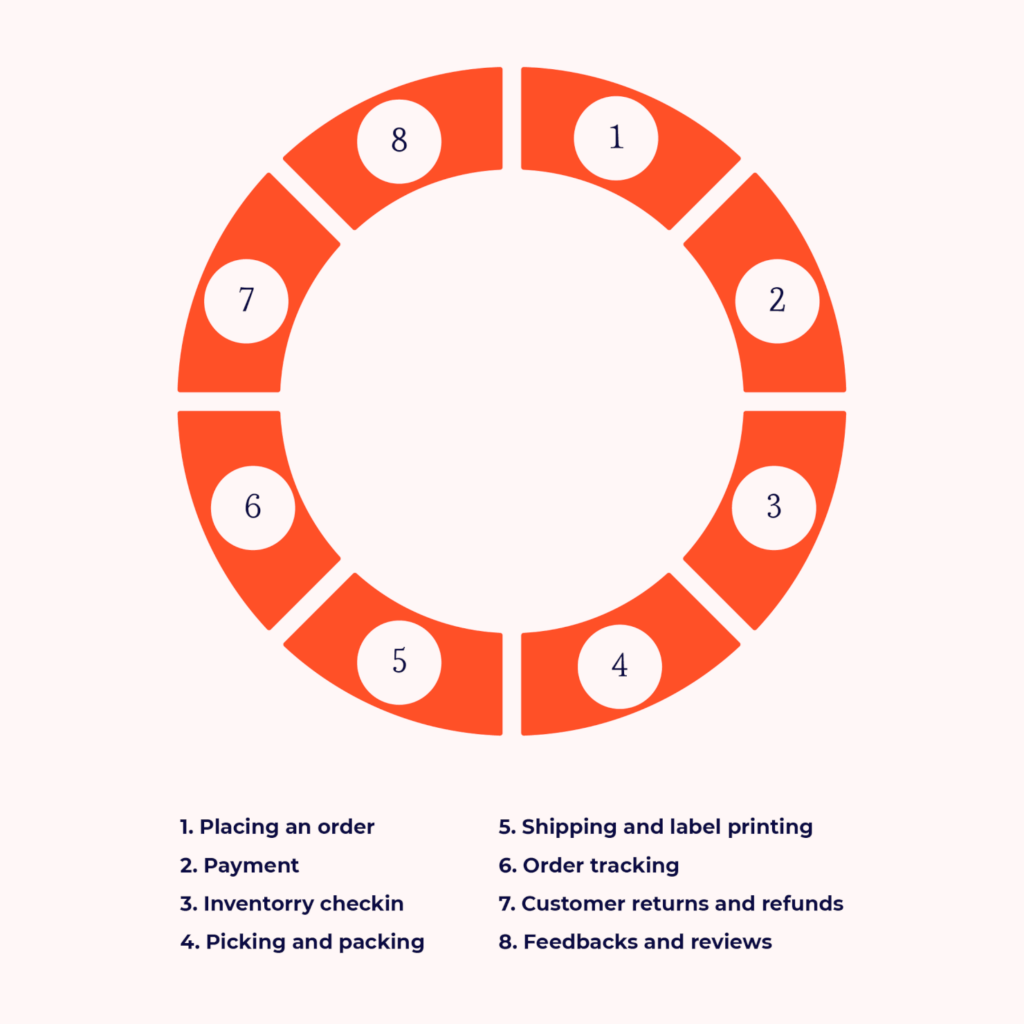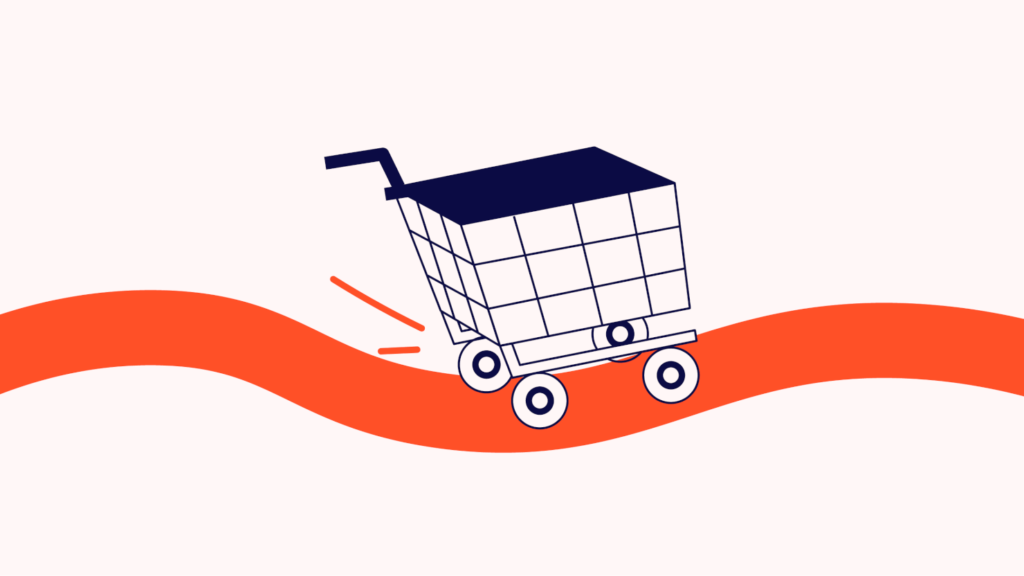If you haven’t already, it’s probably time to start looking at an order management system for your ecommerce business.
In the U.S., 43% of ecommerce businesses track their inventory using a spreadsheet or pen and paper. On top of this, 34% of businesses have shipped an order late or not at all because their stock levels are not accurate!
Errors like this cause a lot of customer confusion and can have a huge negative impact on your business’ reputation.
Order management touches every part of your ecommerce business, and it starts before the customer has even clicked the buy button. But order management doesn’t just mean order tracking. It also includes inventory management, customer feedback, picking and packing, and returns.
When your business is starting out, it’s quite straightforward to keep on top of orders. But in the modern ecommerce world, where you can quickly expand to new geographies and sell in multiple marketplaces fulfilling orders from multiple warehouses, managing orders can become very complicated very quickly.
This is why brands are now more likely to use an order management system (OMS) to keep their orders organized and their customers happy.
But there are a lot of different types and brands of OMS, and it can get confusing, especially if this is your first time using one!
To help you out, I’ll go through the features of an OMS and how to choose one for your ecommerce brand.
What Is Order Management?
Order management is the entire lifecycle from the customer placing the order to them receiving the product.
While there are a lot of moving parts involved when a business starts to scale, there are 8 main steps that every ecommerce business needs to follow:
- Placing an order
- Payments
- Inventory checking and inventory management
- Picking and packing (and packaging)
- Shipping and label printing
- Order and shipment tracking
- Customer returns and refunds
- Feedback and reviews

What Is An Order Management System?
An order management system is any system you use to manage all the steps in the order fulfillment process. But your system doesn’t need to be complicated and expensive.
When I started out selling online, my order management process involved using spreadsheets and Google Drive folders, but this very quickly became very time intensive and human error-prone!
That is why many businesses use specific software to track their orders and integrate the details with other parts of the business, such as customer relationship management systems (CRM), supplier systems, and inventory management software.
Order Management System Key Features
Whilst every business is different, all order management systems for ecommerce businesses will include some of the main features below.
The best order management software will scale with your business, so as you grow, your system can become more comprehensive to match your needs.
1. Enable purchase orders to be placed
Firstly, any order fulfillment process must enable customers to place an order. When the customer places the order, the customer should know that the order has been securely processed and receive an order status notification.
Sometimes this process will be automated if you use an ecommerce platform like Shopify.
However, if you are using a custom site or a customized WordPress platform, you might need to manually integrate the order placement process with the rest of your order management system.
The most important part of an order management solution is reassuring your customers that their order has been placed securely and it will be delivered on time.
This might sound very obvious, but there are some important things to consider when setting up a customer order process, such as:
- Shipping costs to different geographical locations
- Coupon codes and promotions
- Stock levels
- Customer details
All of this information needs to be passed on to the rest of your supply chain.
2. Inventory management
Before a customer places an order, they need to know whether the product is in stock.
This means that your order management system has to integrate well with your inventory management. The customer needs to know the inventory availability. If the product is out of stock, then they also ideally want to know when the product will be back in stock to avoid disappointment.
In modern ecommerce businesses, stock may be held across various locations, including in-store. Managing stock is one of the biggest challenges facing ecommerce businesses, so you must get this part right.
Without an OMS platform, tracking inventory levels can become very difficult very quickly. Some of the problems that can arise include overstocking and overselling, both of which can have a huge impact on your supply chain and profit margin, especially once your business starts to scale.
A good OMS will update stock levels in real-time, giving you confidence that your customers are getting an amazing service.
3. Order accuracy
When you start out selling online, a simple email with a tracking number is more than enough information for a customer. However, imagine having to send 20+ emails a day with tracking information. This could take two hours a day by itself!
Order tracking isn’t just meant to improve customer satisfaction. It's also a huge benefit for your customer support team. If a customer has an inquiry about an order, your customer service representative needs to be able to see where the order is and what the ETA is.
Some order management systems have order tracking software and order entry and processing built into the system, such as Amazon FBA orders. But if you aren’t using a pre-built platform, you should choose an OMS that integrates with a logistics company such as UPS or Yodel so you can meet customer expectations for updates on their order.
4. Manage returns
Returns are an unfortunate part of any ecommerce business, so you should make that process as optimized as possible. It’s important for your systems so you can update the inventory level, but it's even more important for customers.
Having a streamlined and easy returns process on your OMS can get your business more sales. Whilst this sounds counterintuitive, 85% of shoppers check the returns policy before making a purchase. Companies like Amazon and ASOS have built customer trust thanks to their straightforward returns processes.
A great OMS will give you many options for returns, including:
- Coupons or vouchers in exchange for returns
- Exchanges of like-for-like products
- Partial order returns
- Manage incoming stock and return it to the warehouse
- Automatically printed return labels
- Return tracking information
A system that includes all these features will provide an excellent customer experience and, in the long run, improve the reputation of your business.
5. Marketing and CRM integration
Understanding your customers’ habits is very important when you are trying to grow your business. By integrating your OMS with your marketing software, you can start to gain insights into your customers’ behavior.
Some important information to gather is previous sales orders, location, and interactions with customer service.
Gathering order data like this will enable you to send customized communications to the customer, which gives the customer a more personalized experience.
For example, if your customer has ordered a lot of women’s clothes, it might not make sense to send them lots of emails about your new men’s range.
6. Reporting and financial data
Whilst it is important to make sure your customer has a great experience, it is also important to understand how your business is performing on a day-to-day basis. A great OMS will either have comprehensive reporting or integrate with reporting software.
The most important example of this is your accounting software. Ecommerce accounting involves a lot of moving parts, and manually adding all this information to Xero, Quickbooks commerce, or other accounting software can be very time-consuming for your bookkeeper, especially if the bookkeeper is also you.
Some software integrates directly with your accounting software to break your sales down to help you manage cash flow and financial forecasting. If you use a third-party platform such as Etsy or Amazon, you can use third-party software that communicates with your accounting software, such as A2X or Link My Books.
7. Automations
Manually processing orders can be very time-consuming, especially if you are working with multiple sales channels. When I started selling on Etsy, I fulfilled all my orders from Amazon’s FBA warehouse by creating multichannel fulfillment orders, which was fine at first, but the manual process very quickly started taking up a lot of my time.
A good OMS will be able to automatically create an order, send the customer a notification, create a picking order, print a packing slip and shipping label, update inventory, and arrange shipment. It will also store analytics on everything to do with the shipment so you can get detailed reports on the health of your business.
How To Choose An Order Management System
Choosing the right order management software for your business is an important decision, whether this is your first time choosing the software or you are looking to upgrade your current systems.
There are lots of different factors you need to take into account, including your budget, sales channels, and what other software you already use.
This is the process I go through for choosing a new OMS:
1. Define your goals
Buying any new software can be an expensive decision, especially if you choose something unnecessary for the size of your business. So the first step is to understand exactly what you need the software to do.
Go through the features I have outlined above once more, and then go through how you already manage those business processes today. You must choose a software provider that can scale with your small business, so make sure that you understand all the processes you currently have and how they will change as you grow.
Also, you should consider how your team is already set up. If you use a third-party warehouse management system, for example, you need to make sure that any new software will integrate with their tools.
Speak to all the team members you have across all the functions I outlined in the features section to make sure you understand their requirements.
2. Integrations
Once you have spoken to all your team members, the next step is to make sure that the software you choose is compatible with any tools you want to continue using.
You might not be at the stage when you can get a full Enterprise Resource Planning (ERP) for your business, which means you will probably continue to use a lot of the software tools you use today.
The most important integration will be with your payments system and front-end customer-facing system (such as your POS). Without these workflows, you can’t make any money.
3. Usability
What is the technical knowledge of your team? Unless you have a team of developers, having a fully customized OMS might cause you headaches down the line.
Even with a simple plug-and-play OMS, you will need to make sure the software is simple enough for all your team members to understand, from people in the warehouse to your customer service.
4. Budget
Order management software starts at $0 and goes all the way into the thousands per month.
Work out how much you can afford to spend and look at options within your budget. The best OMS will scale with your business, so you might be able to start on a free or very cheap plan and scale up as your business grows.
Most OMS will increase in price as your orders increase, but some will also take into consideration the number of SKUs you have or the number of integrations you use.
When your business has multiple members of staff, it might be time to upgrade to a more customized option that works for your business. If this is the case, you can get a tailored quote, and the software providers will usually want to know your technical requirements, including:
- Number of SKUs
- Volume of orders
- Number of customers
- Required integrations
Create a list of the requirements you need, and it will help you to decide which software to use.
5. Other considerations
It might be difficult to find your ideal 100% match OMS, but the most important things to consider are the current integrations, scalability, and customer-facing options.
When you put together a shortlist of the best order management systems for your business, think about these questions to help you make a final decision:
- Does the system integrate with the software I want to continue to use?
- Does the customer-facing portal fit in with what my ideal customer would expect?
- Will the software scale as my business grows?
- Can the software integrate with third-party businesses such as warehouses and delivery teams?
- What is the support like if there is an issue?
- Is the software good value for money?
Need expert help selecting the right eCommerce Solutions Software?
If you’re struggling to choose the right software, let us help you. Just share your needs in the form below and you’ll get free access to our dedicated software advisors who match and connect you with the best vendors for your needs.
Which Order Management System Will You Choose?
Order management is the most important part of an ecommerce business, touching everything from a customer placing an order to receiving the parcel.
A great order management process will leave your customers raving about your brand and will increase the likelihood of them coming back. Order management software is what brings all the processes together and streamlines your ecommerce operations, and choosing the right system for your business is an important decision.
Start with understanding where your order management process is now and where you want it to go. Once you have a firm grasp on that, it will make choosing the right software much more straightforward.
As a great place to start, check out this shortlist of the best order management software on the market today.
Don't forget to also subscribe to The Ecomm Manager newsletter for more essential tips and advice on order management and more for your online store!
More great ECM content:



